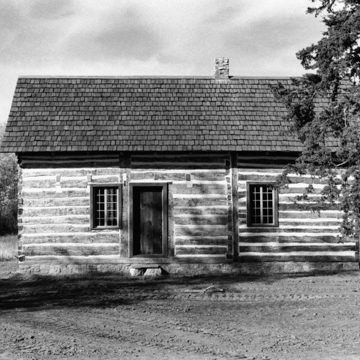Built during the heyday of the fur trade, this house may be the oldest building in Wisconsin standing on its original site. Vertefeuille was one of the French Canadians who came to Prairie du Chien in the late eighteenth and early nineteenth centuries to barter for pelts with local Indians. Like many traders, he gave up fur for farming. He secured a farm lot in 1809 and acquired this house and small village lot about a decade later. The original house (the southern two of the present three bays) was built between 1805 and 1820 and enclosed one room and a loft. The construction technique was pièce-sur-pièce en coulisse, standard in early Prairie du Chien. Hewn maple logs, stacked horizontally, meet in the middle of each wall at a coulisse, a vertical post that is deeply grooved from top to bottom on either side. Tenons at the ends of the horizontal logs fit into the grooves and are secured with pegs. Around 1825, when Vertefeuille added another room, he used this same technique. The coulisse is visible in the center of the north-facing wall. Both Vertefeuille and the original builder used half-dovetail notching to tie the corners of the structure.
The house and its small lot were originally part of a village. Outside the village lay the larger strips of land where Vertefeuille and his neighbors farmed. Responding to the area’s topography and drawing on a French feudal form, this pattern was characteristic for French communities in Missouri, Louisiana, the Great Lakes area, and Canada, where settlers built their houses along waterways and cultivated narrow long lots that stretched inland from the river, thereby ensuring access to the waterway and thus transportation.
The Vertefeuille House stood abandoned for years after the disastrous Upper Mississippi flood of 1965 filled it with silt. The current owners have restored the house to its early-nineteenth-century appearance.


